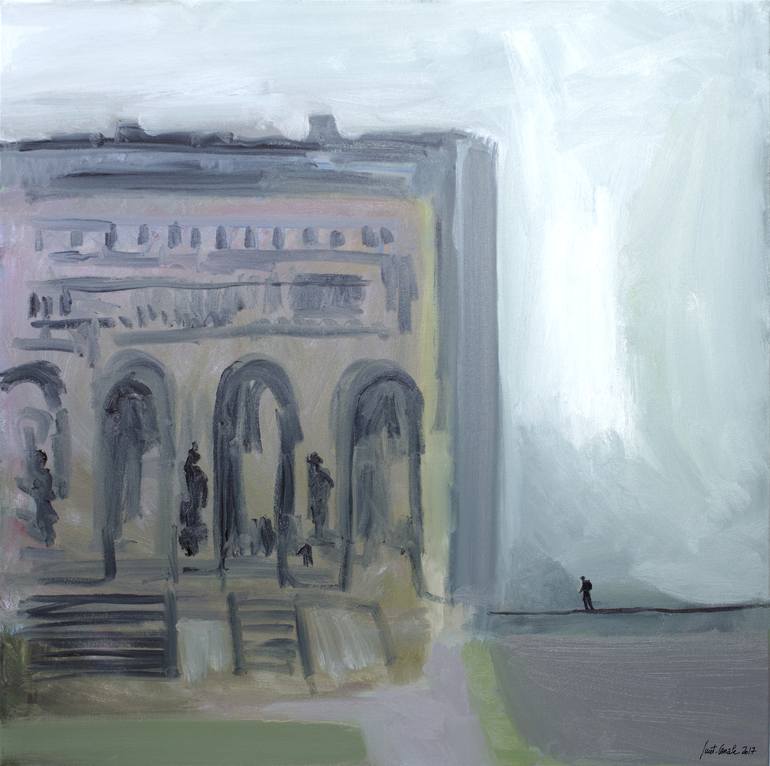






VIEW IN MY ROOM
the Prodigal Son Painting
France
Painting, Oil on Canvas
Size: 31.5 W x 31.5 H x 2 D in
Ships in a Box
About The Artwork
Parable of the Prodigal Son is one of the parables of Jesus and appears in Luke 15:11–32. Jesus Christ shares it with his disciples, the Pharisees and others. In the story, a father has two sons. The younger son asks for his inheritance and after wasting his fortune (the word "prodigal" means "wastefully extravagant"), becomes destitute. He returns home with the intention of begging his father to be made one of his hired servants, expecting his relationship with his father is likely severed. The father welcomes him back and celebrates his return. The older son refuses to participate. The father reminds the older son that one day he will inherit everything. But, they should still celebrate the return of the younger son because he was lost and is now found. My painting as you can see is not a literal illustration, and treats the biblical subject in a way that is not usual. I chose the moment, or the wretched son, who has failed in his life project, returns to his father's dwelling, worried about how he will be received by his father, for it is this feeling of the son and this anxiety that interests me to translate. From a painter's point of view, this painting can be considered as a metaphor, treated in a very classical harmony of gray, very subtle from the point of view of the colors, and one can see there a return of the painter to the Reason after having devoted himself to the debauchery of colors, for the painter as well as the prodigal son always returns to the grays which are the paternal house of the painter. There is for sure other way to interpret this painting, but I wanted to quote at least two, to you to look for other possible
Details & Dimensions
Painting:Oil on Canvas
Original:One-of-a-kind Artwork
Size:31.5 W x 31.5 H x 2 D in
Frame:Not Framed
Ready to Hang:Not applicable
Packaging:Ships in a Box
Shipping & Returns
Delivery Time:Typically 5-7 business days for domestic shipments, 10-14 business days for international shipments.
Handling:Ships in a box. Artists are responsible for packaging and adhering to Saatchi Art’s packaging guidelines.
Ships From:France.
Have additional questions?
Please visit our help section or contact us.
Michel Suret-Canale (born March 4, 1957) is a French artist from Paris. Born in the suburb of Boulogne-Billancourt on March 4, 1957, Michel Suret-Canale spent his childhood in the artistic center of Paris, growing up in the home of his grandfather, medalist and publisher of art medals Victor S. Canale (1883–1958) who was also a sculptor, ceramicist, printmaker and inventor. He is the son of the late Jean Suret-Canale (1921–2007), an extensively published author, French historian of Africa, World War II resistance fighter and Georgette (Lamargot) Suret-Canale, World War II resistance fighter to, a poet and journalist. Michel Suret-Canale decided to become an artist by the age of 14. After his secondary education at the Lycée Claude Bernard in Paris, Michel enrolled at the University of Arts and Sciences of Art, Department of Paris I Panthéon Sorbonne, eventually earning a doctorate in Arts and Sciences of Art with honors by unanimous decision of the jury. Throughout the years Michel Suret-Canale has found ways to express himself artistically in various disciplines including scenography, publication, graphics and multimedia. Between 1984 and 2007 he did extensive work with the troupe of French theatrical clowns, Les Matapeste, with his contributions including set and costume design, advertising posters, photography and the design of their Website. He has all his life conducted ongoing research in methods of digital art, the results of which can be seen in his robotic paintings as well as his New York RE-Views series of combine paintings from the summer of 2008. As a visual artist, Michel Suret-Canale is one of the first artists to look beyond selling through agents and galleries by offering his work on eBay auctions, enabling him to be in direct contact with collectors. While at first this met with some criticism, it was soon to prove a viable method of introducing his art to a worldwide audience. Suret-Canale's artwork has been shown in exhibitions throughout France as well as in Spain, Great Britain, Moscow, Casablanca (Morocco) and the United States. His artworks are present in more than 600 private collections in 28 different countries all over the world.
Thousands Of Five-Star Reviews
We deliver world-class customer service to all of our art buyers.
Global Selection
Explore an unparalleled artwork selection by artists from around the world.
Satisfaction Guaranteed
Our 14-day satisfaction guarantee allows you to buy with confidence.
Support An Artist With Every Purchase
We pay our artists more on every sale than other galleries.
Need More Help?